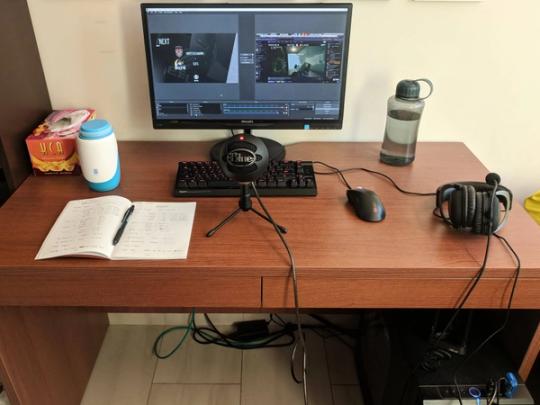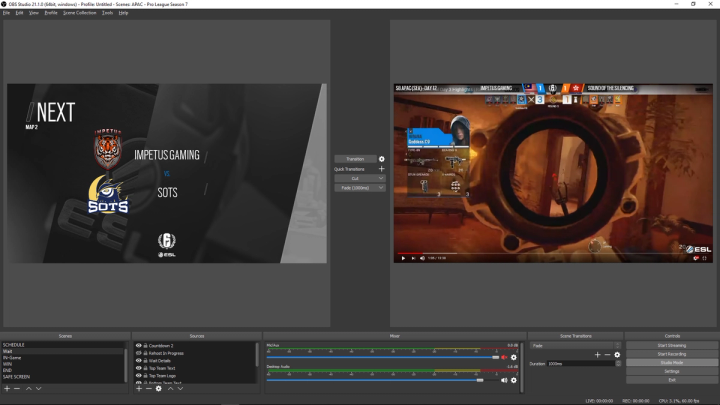
The Southeast Asian Pro League (in English), Cyberathlete Championship Series (CCS), and OGA Pit (North America) all share two things in common -- one, that they are Rainbow Six leagues, and two, they are all home broadcasted. With all these leagues pretty significant to the Rainbow Six scene, we decided to have a look at what makes them different to the studio broadcasts that are more commonly seen in the NA, EU, and LATAM Pro League.
Studio Broadcasts
To start with, let’s have a look at what a studio broadcast looks like and how it works. Much of this information is generalised, and may differ for studios such as the OGA Pit or those that handle the NA, EU, LATAM, and APAC Pro League.

Picture: Ghassan "Milosh" Finge (via Twitter)
Behind the pretty front of the desk that we all get to see on the broadcast, each caster gets one monitor to watch the “cleanfeed” from. Each caster wears a headset, and has a mini control panel on the desk with two buttons. One allows him/her talk to the production crew (where he cannot be heard by the stream), and the second is a push-to-mute button if someone needs to cough, drink water, or even take a quick bite (which is more common that many would expect).
Behind the scenes we have a local cleanfeed operator operating behind the curtains. To put it simply, the cleanfeed is the unadulterated feed from the observer’s PC sent over to multiple places. One goes to the casters’ monitors, another goes to the broadcast director (the final authority on what goes to your PC screens), and in some cases it is sent over to other studios’ broadcast directors across the world for broadcasts in different languages. For example, if OGA Pit's EU broadcasters also wanted a secondary stream in, say, French, they could simply allow the French casters remote access (through means such as an unlisted YouTube stream) to the cleanfeed and let them handle the rest of the production on their end.
The broadcast director’s station is where it all comes together. The overlay is added, the different scenes are prepared (in-game, interview, schedule etc.), and the broadcast is sent out to Twitch and sometimes to YouTube as well to be viewed as the final stream.
Home Broadcasts
Home broadcasts, are obviously, fairly different -- but similar enough that not much looks worse. Often, quality is lower, and many streams are vulnerable to the vagaries of internet of the casters and/or cleanfeed operator but everyone involved tries their best to bring the best possible finished product to the table. For this article, I will be using the SEA Pro League English broadcast as an example, and while other home broadcasts will be fairly similar, they are bound to have some small differences as well.

Notebook, hot water, cold water, and tissues are optional but greatly enhance the casting
A home broadcast, compared to the studio, is far simpler in terms of the equipment required. All that is needed is a decently strong PC for one caster, any PC capable of running Discord, TeamSpeak, or Skype for the other, and a strong PC for the cleanfeed operator. Some casters also choose to pair their headsets with dedicated microphones like the Blue Yeti for enhanced audio.
The cleanfeed operator in a home broadcast has a somewhat different job. He or she needs to simply stream the game to an unlisted YouTube stream, and sit in the same voice call as the casters to stay aware of the flow of the cast. Sometimes, the cleanfeed is watched by multiple language’s casters just like in some studio broadcasts.
Unfortunately, while studio broadcasts allow casters to directly request the observer to show a certain location or the scoreboard without delay, online broadcasts have about a ten-second delay before the request gets reflected on the cleanfeed. Similarly, while ESL admins watch the cleanfeed, authorisation for rehosts take some time to show up.
The casters, on the other hand, have two roles. One is simply in the voice call and can focus purely on casting. The other, though, fulfills the role of the broadcast director as well. He or she receives the cleanfeed, adds the overlay, prepares the scenes etc. in programmes such as Open Broadcasting Software (OBS), and then sends it out to the Twitch stream -- a double stream to YouTube is rarely done as it taxes the PC significantly.

What the Season 8 SEA Pro League English broadcast looked like in OBS
In a home broadcast, though, both casters need to carry out an additional step before beginning to cast -- achieving synchronisation to ensure they are both seeing the same moment in the cleanfeed. While this is a simple process, it’s necessary to prevent one caster from being ahead of the other, resulting in the other either “living in the future” or “lagging in the past”.
Of course, with a home broadcast, technical difficulties are far more common and it is harder to match the technical quality of a studio broadcast. The two key factors to a home broadcast are the strength of the observer’s and broadcasting caster’s PC, and the internet connection of all three parties involved in the production.
Silicon lotteries and the individual’s purchasing decision can determine just how good the game can be made to look and how high quality a stream can be output, and stable and quick internet connections keep the stream going smoothly. And sometimes, the tech simply hates you and refuses to let hiccups like stuttering or unstable framerate disappear.
Finally, with a lack of budget that necessitate home broadcasts in the first place, the production team behind these home broadcasts are sometimes unpaid. This volunteer work thus becomes an important lens to judge the production value of these home broadcasts as it is extremely hard to match the level of studio productions.
---
Season 9 of the SEA Pro League starts on 16 January, with CCS scheduled to continue Season 4 the week after the 2019 Six Invitational. Catch these leagues in action if you can, and support the various people making these broadcasts happen to bring some top-class competitive Siege action to your screens.
